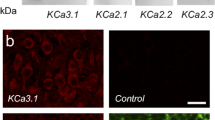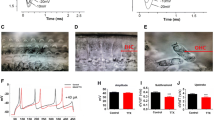Abstract
The pharmacological and biophysical properties of large-conductance Ca-activated K (BK) channels from embryonic rat telencephalic neuroepithelium were investigated with in situ patch-clamp techniques. A fraction of these channels exhibited properties characteristic of BK channels recorded in well differentiated cells, including normal gating mode (BKN channels). The vast majority of BK channels expressed distinctive properties, the most conspicuous being their buzz gating mode (BKB channels). BKB channels were insensitive to a concentration of charybdotoxin that completely and reversibly blocked BKN channels. In contrast with the strict dependence of BKN channel activation on cytoplasmic Ca, BKB channels displayed substantially high open probability (P o) after inside-out patch excision in a Ca-free medium. Intracellular trypsin down-regulated theP o of BKB channels, which then exhibited a greater sensitivity to cytoplasmic Ca, mainly in the positive direction (increasedP o with increased Ca). This suggested a modulatory role for Ca as opposed to its gating role in BKN channels. Ca ions also reduced current amplitude of both types of channels. BKB channels were less voltage sensitive than BKN channels, but this was not correlated with their lower Ca sensitivity. We speculate that BKB channels may represent immature forms in the developmental expression of BK channels.
Similar content being viewed by others
References
Adelman JP, Shen KZ, Kavanaugh MP, Warren RA, Wu YN, Lagrutta A, Bond CT, North RA (1992) Calcium-activated potassium channels expressed from cloned complementary DNAs. Neuron 9:209–216
Bayer SA, Altmann J (1991) Neocortical development. Raven, New York
Blair LA, Dionne VE (1985) Developmental acquisition of Ca2+-sensitivity by K+ channels in spinal neurones. Nature 315:329–331
Bouzat C, Bren N, Sine SM (1994) Structural basis of the different gating kinetics of fetal and adult acetylcholine receptors. Neuron 13:1395–1402
Bregestovski PD, Printseva OY, Serebryakov V, Stinnakre J, Turmin A, Zamoyski V (1988) Comparison of Ca2+-dependent K+ channels in the membrane of smooth muscle cells isolated from adult and foetal human aorta. Pflügers Arch 413:8–13
Bulan EJ, Barker JL, Mienville J-M (1994) Immature maxi K channels exhibit heterogeneous properties in the embryonic rat telencephalon. Dev Neurosci 16:25–33
Butler A, Tsunoda S, McCobb DP, Wei A, Salkoff L (1993)mSlo, a complex mouse gene encoding “Maxi” calcium-activated potassium channels. Science 261:221–224
Chakrabarti AK, Banik NL, Lobo DC, Terry EC, Hogan EL (1993) Calcium-activated neutral proteinase (calpain) in rat brain during development: compartmentation and role in myelination. Dev Brain Res 71:107–113
Chouinard H, Caldwell JH, Ribera AB (1994) Expression ofslo transcripts in the embryonicXenopus laevis nervous system. Soc Neurosci Abstr 20:77
Edwards FA, Konnerth A, Sakmann B, Takahashi T (1989) A thin slice preparation for patch clamp recordings from neurones of the mammalian central nervous system. Pflügers Arch 414:600–612
Egan TM, Dagan D, Levitan IB (1993) Properties and modulation of a calcium-activated potassium channel in rat olfactory bulb neurons. J Neurophysiol 69:1433–1442
Fabiato A, Fabiato F (1979) Calculator programs for computing the composition of the solutions containing multiple metals and ligands used for experiments in skinned muscle cells. J Physiol (Paris) 75:463–505
Fagaly T, Lipscombe D (1994) Single channel studies of two “large” conductance Ca-activated K channels in sympathetic neurons. Soc Neurosci Abstr 20:1521
Franciolini F (1988) Calcium and voltage dependence of single Ca2+-activated K+ channels from cultured hippocampal neurons of rat. Biochim Biophys Acta 943:419–427
Holliday J, Adams RJ, Sejnowski TJ, Spitzer NC (1991) Calcium-induced release of calcium regulates differentiation of cultured spinal neurons. Neuron 7:787–796
Khan RN, Smith SK, Morrison JJ, Ashford MLJ (1993) Properties of large-conductance K+ channels in human myometrium during pregnancy and labour. Proc R Soc Lond Biol 251:9–15
Kramer RH (1990) Patch cramming: monitoring intracellular messengers in intact cells with membrane patches containing detector ion channels. Neuron 4:335–341
Lagrutta A, Shen KZ, North RA, Adelman JP (1994) Functional differences among alternatively spliced variants ofslowpoke, aDrosophila calcium-activated potassium channel. J Biol Chem 269:20347–20351
Latorre R (1994) Molecular workings of large conductance (maxi) Ca2+-activated K+ channels. In: Peracchia C (ed) Handbook of membrane channels. Academic, San Diego, pp 79–102
Martell AE, Smith RM (1974) Critical stability constants, vol 1. Plenum, New York
McManus OB (1991) Calcium-activated potassium channels: regulation by calcium. J Bioenerg Biomembr 23:537–560
McManus OB, Helms LMH, Pallanck L, Ganetzky B, Swanson R, Leonard RJ (1995) Functional role of the β subunit of high conductance calcium-activated potassium channels. Neuron 14:645–650
Mienville J-M (1994) Gating mode conversion by proteolysis in a large-conductance K+ channel from embryonic rat telencephalon. J Physiol (Lond) 481:293–298
Mienville J-M, Lange GD, Barker JL (1994) Reciprocal expression of cell-cell coupling and voltage-dependent Na current during embryogenesis of rat telencephalon. Dev Brain Res 77:89–95
Moczydlowski E, Latorre R (1983) Gating kinetics of Ca2+-activated K+ channels from rat muscle incorporated into planar lipid bilayers. J Gen Physiol 82:511–542
Monyer H, Burnashev N, Laurie DJ, Sakmann B, Seeburg PH (1994) Developmental and regional expression in the rat brain and functional properties of four NMDA receptors. Neuron 12:529–540
Reinhart PH, Chung S, Levitan IB (1989) A family of calcium dependent potassium channels from rat brain. Neuron 2:1031–1041
Salomao L, Wark G, Dubinsky WP, Schultz SG (1992) Effect of trypsin on Ca2+-activated K+ channel reconstituted into planar phospholipid bilayers. Am J Physiol 262:C971–C974
Selyanko AA, Brown DA (1994) Properties of potassium M-channels in inside-out patches excised from rat sympathetic neurons. Soc Neurosci Abstr 20:1519
Smith CWJ, Patton JG, Nadal-Ginard B (1989) Alternative splicing in the control of gene expression. Annu Rev Genet 23:527–577
Tseng-Crank J, Foster CD, Krause JD, Mertz R, Godinot N, Dichiara TL, Reinhart PH (1994) Cloning, expression, and distribution of functionally distinct Ca2+-activated K+ channel isoforms from human brain. Neuron 13:1315–1330
Vicini S, Schuetze SM (1985) Gating properties of acetylcholine receptors at developing rat endplates. J Neurosci 5:2212–2224
Warm KT, Richards CD (1994) Properties of single calcium activated potassium channels of large conductance in rat hippocampal neurons in culture. Eur J Neurosci 6:607–617
Wei A, Solaro C, Lingle C, Salkoff L (1994) Calcium sensitivity of BK type KCa channels determined by a separable domain. Neuron 13:671–681
Yoshida A, Oda M, Ikemoto Y (1991) Kinetics of the Ca2+-activated K+ channel in rat hippocampal neurons. Jpn J Physiol 41:297–315
Yu YY, Brenner R, Becker M, Pollak G, Atkinson NS (1994) Alternative exon utilization of a calcium-activated potassium channel inDrosophila melanogaster. Soc Neurosci Abstr 20:721
Author information
Authors and Affiliations
Rights and permissions
About this article
Cite this article
Mienville, JM., Barker, J.L. Immature properties of large-conductance calcium-activated potassium channels in rat neuroepithelium. Pflugers Arch. 431, 763–770 (1996). https://doi.org/10.1007/BF02253841
Received:
Revised:
Accepted:
Issue Date:
DOI: https://doi.org/10.1007/BF02253841




